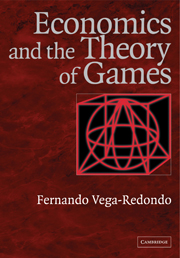Book contents
- Frontmatter
- Contents
- Preface
- 1 Theoretical framework
- 2 Strategic-form analysis: theory
- 3 Strategic-form analysis: applications
- 4 Refinements of Nash equilibrium: theory
- 5 Refinements of Nash equilibrium: applications
- 6 Incomplete information: theory
- 7 Incomplete information: applications
- 8 Repeated interaction: theory
- 9 Repeated interaction: applications
- 10 Evolution and rationality
- 11 Learning to play
- 12 Social learning and equilibrium selection
- Bibliography
- Index
4 - Refinements of Nash equilibrium: theory
Published online by Cambridge University Press: 03 June 2010
- Frontmatter
- Contents
- Preface
- 1 Theoretical framework
- 2 Strategic-form analysis: theory
- 3 Strategic-form analysis: applications
- 4 Refinements of Nash equilibrium: theory
- 5 Refinements of Nash equilibrium: applications
- 6 Incomplete information: theory
- 7 Incomplete information: applications
- 8 Repeated interaction: theory
- 9 Repeated interaction: applications
- 10 Evolution and rationality
- 11 Learning to play
- 12 Social learning and equilibrium selection
- Bibliography
- Index
Summary
Introduction
The Nash equilibrium concept is the central theoretical tool most frequently used in the analysis of noncooperative games. As explained in Subsection 2.2.1, it may be conceived as a basic requirement for strategic stability (i.e., a necessary condition) in the sense that any prediction for a game that embodies rational behavior and accurate (or rational) expectations must be a Nash equilibrium.
However, given the multiplicity of Nash equilibria encountered in many games of interest, the conditions characterizing this equilibrium often prove insufficient to pin down a unique outcome. Then, what we need are further criteria of strategic stability that, in addition to those embodied by the Nash concept, might permit a fruitful (ideally unique) equilibrium selection. In fact, one such possibility has already been considered in Section 2.5. There, it was suggested that, for a strategic configuration to be judged stable, it should be immune not only to unilateral deviations but also to those involving multilateral coalitions. Such a demand, however, turned out to be too stringent since it was shown incompatible with existence even in rather simple games. This is why, by and large, game theory has advanced along this line by proposing further criteria of strategic stability that are strictly unilateral, i.e., individual based. This approach has given rise to a wide range of so-called refinements of Nash equilibrium, the object of the present chapter.
Our ensuing discussion of this topic is divided into three parts.
- Type
- Chapter
- Information
- Economics and the Theory of Games , pp. 110 - 150Publisher: Cambridge University PressPrint publication year: 2003



